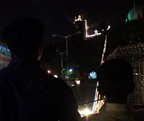
At the General Post Office, Mumbai
There are many ways to locate a city. One way is to distance oneself from it- to look it up in an atlas, a picture, or to go out to sea or up a hill to watch the twinkling lights, and point out the streets we know. Another way is to move within the streets themselves; to awaken the more proximate senses, to touch the city itself. The historical space between and across these two extremes is richly populated: by maps, movies, mondo nuovo, grids and drifts, 'oramas and 'oscopes, flaneurs, heterotopias, travelling shots and shooting travelers.
In recent times, Global Positioning Systems (developed originally for US military use) have allowed for an unprecedented connection between the mover and the map. GPS devices tell us where we are at all times, everywhere on the globe. Implying that we will travel, globally. In Glow Positioning System--by Ashok Sukumaran--a different kind of travel is implied. This is an interior voyage, a circular tourism of a place we know.
A 1000-foot ring of lights encircles the General Post Office intersection in Fort, Mumbai. The lights travel between buildings, across roads and onto trees and lampposts, forming an image-scape that is starkly visible at night. A hand-crank mounted on the pavement provides a way for the audience to "scroll" this landscape. It allows the physical length of the view to become a chronological one- to be viewed at a speed determined by the user.
The ring responds to panoramic desire, that age-old search for an image to immerse our selves in. From Cycloramas to VR (via the tradition of urban panoramas in painting and photography), the "surround view " has been a recurring element of urban and cinematic manifestos. Of course, the city surrounds us already. Here we just connect the dots, and look again.
In any city, various forms of lighting create a distinct nighttime experience - floating us away from from the concrete views of daylight. In India, this is a pervasive medium- think of Diwalis in the city, or weddings, for example. Chases, bursts and strobes provide moving effects, a vivid transarchitecture. "Chinese" string lights - they cost about $2 for 14 feet - have made a nighttime "presence" feasible for almost anybody. For this project, such lights (and others) were installed on the facades and rooftops (and sometimes interiors) of several homes , a real-estate office, a razor-blade manufacturer's office, a transit lodge, an abandoned bank, several shops and restaurants, and a 150-year old "heritage" structure (the GPO). Local lighting decorators I was working with designed and installed the lighting, in collaboration with home and office owners.
The lights are then connected in a virtual loop, which overlays the concrete urban architecture and the electrical grid. The hand-crank interface is mounted on the pavement near the Kabutarkhana (pigeon coop) . As you turn the crank, the lit part of the ring of lights moves, for example from the Kothari building onto the trees, or from one minaret to the next. Changing the speed of rotation causes variable persistence effects, both actual and perceived. A path of movement is traced upon the concrete city, and our heads turn to meet it. The crank mechanism itself refers to not only its specific history in the moving panorama, but also a general history of the moving image: as a driver for cinema. Like cinema, the experience does not depend on the observer being physically displaced. Yet there is the clear sense of an actual landscape, and the promise of a haptic journey.
This entire project is a kind of poetic infrastructure, a layer on top of the urban design and conservation Plans that define "inner city" precincts. In a playful and accessible way, it attempts to rewire the use-based definitions (post office, eating, shopping, etc) of this public space.
Glow Positioning System was commissioned for the Mumbai Festival 2005 by the Jindal South-West Foundation.
![]()
Ashok Sukumaran was recently awarded the main prize of the UNESCO Digital Arts Award 2005-"City and Creative Media".

